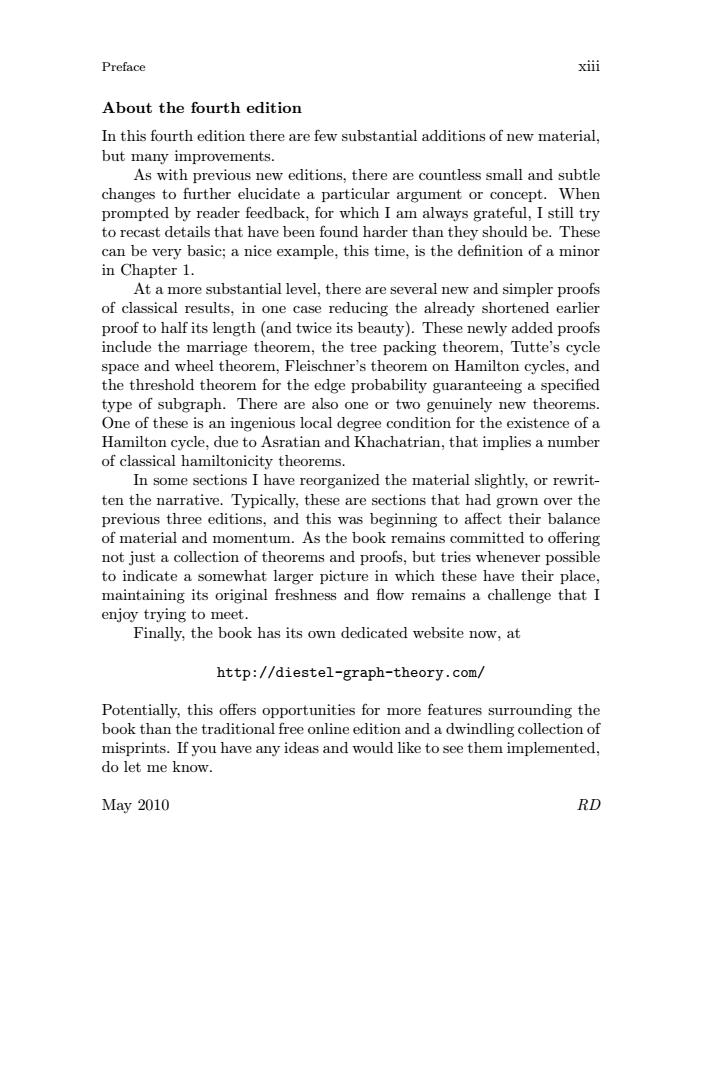正在加载图片...

xiiPrefaceAboutthefourtheditionIn this fourth edition there are few substantial additions of new material, but many improvements.As with previous new editions, there are countless small and subtlechanges to further elucidate a particular argument or concept. Whenprompted by reader feedback, for which I am always grateful, I still tryto recast details that have been found harder than they should be. Thesecan be very basic; a nice example, this time, is the definition of a minorin ChapterAtamoresubostantiallevel.thereralnewandsimareseyDlerproof classical results, in one case reducing the already shortened earlierproof to halfits length (and twice its beauty),These newly added proofsinclude the marriage theorem, the tree packing theorem, Tutte's cyclespace and wheel theorem, Fleischner's theorem on Hamilton cycles, andthe threshold theorem for the edge probability guaranteeing a specifiedtype of subgraph.Thereare also one or two genuinely new theoremsOne of theseious local degree cconditionfortheexistenceofaisaninHamilton cycle, due to Asratian and Khachatrian, that implies a numberof classicalnicity theoremsIn some sections I have reorganized the material slightly, or rewrten the narrative. Typically, these are sections that had grown over theprevious three editions, and this was beginning to affect their balanceof material and momentum. As the book remains committed to offeringnot just a collection of theorems and proofs, but tries whenever possibleto indicate a somewhat larger picture in which these have their placemaintaining its original freshness and flow remains a challenge that Ienjoy trying to meet.Finally, the book has its own dedicated website now, athttp://diestel-graph-theory.com/Potentially, this offers opportunities for more features surrounding thebookthan thetraditional free online edition and adwindling collectionofmisprints.Ifyouhaveanyideasand wouldliketoseethemimplementeddo let me know.RDMay 2010Preface xiii About the fourth edition In this fourth edition there are few substantial additions of new material, but many improvements. As with previous new editions, there are countless small and subtle changes to further elucidate a particular argument or concept. When prompted by reader feedback, for which I am always grateful, I still try to recast details that have been found harder than they should be. These can be very basic; a nice example, this time, is the definition of a minor in Chapter 1. At a more substantial level, there are several new and simpler proofs of classical results, in one case reducing the already shortened earlier proof to half its length (and twice its beauty). These newly added proofs include the marriage theorem, the tree packing theorem, Tutte’s cycle space and wheel theorem, Fleischner’s theorem on Hamilton cycles, and the threshold theorem for the edge probability guaranteeing a specified type of subgraph. There are also one or two genuinely new theorems. One of these is an ingenious local degree condition for the existence of a Hamilton cycle, due to Asratian and Khachatrian, that implies a number of classical hamiltonicity theorems. In some sections I have reorganized the material slightly, or rewritten the narrative. Typically, these are sections that had grown over the previous three editions, and this was beginning to affect their balance of material and momentum. As the book remains committed to offering not just a collection of theorems and proofs, but tries whenever possible to indicate a somewhat larger picture in which these have their place, maintaining its original freshness and flow remains a challenge that I enjoy trying to meet. Finally, the book has its own dedicated website now, at http://diestel-graph-theory.com/ Potentially, this offers opportunities for more features surrounding the book than the traditional free online edition and a dwindling collection of misprints. If you have any ideas and would like to see them implemented, do let me know. May 2010 RD